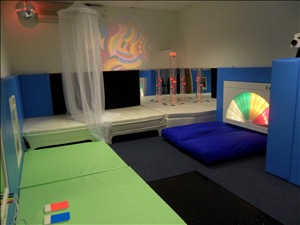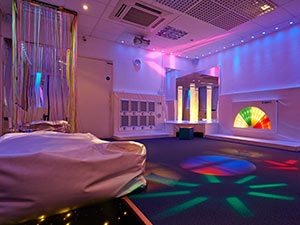Multi-sensory products & equipment
Our comprehensive range of multisensory products and equipment provides a wide choice of options for carers, therapists, parents, teachers and others responsible for catering for people of all ages.
We have supplied products for individual requirements in their homes and installed fully interactive multisensory rooms in various organisations such as special schools, hospitals, aged care facilities and respite centres throughout Australia and New Zealand for many years. As a consequence, we are able to assist in the choice of products, offer a free service in planning and designing a multisensory room and advise in the preparation of submissions for the necessary funding when this is required.

Starting a Sensory Room
The initial stages of a starting a Multisensory Room can be a difficult task. Knowing what the clients sensory needs are, and how they can motivate and improve their sensory awareness is most important.
As the name implies a multisensory environment is one in which a client maybe able to experience the use of one or more of their senses i.e. touch, smell, sound and sight. Such use maybe for education or simply relaxation.
A Multisensory environment can be a space or area set aside for using Multi-Sensory products or it can be a special room dedicated for Multisensory use.
Visual Stimulation

The Multisensory Room can be used to encourage awareness to light and images, tracking and other visual skills. It is all down to your imagination. The Projector, Bubble Tube and Fibre Optics are very powerful tools. Simple items such as the Par Can Light or PinSpot and Colour Wheel can also be used very effectively. Lights can be projected onto tactile objects, pictures and all types of surfaces, reflective, smooth, rough etc.
Hearing
Take a moment to think about your hearing and listening skills. You listen, locate, track and identify frequency and volume enabling sound to be matched to visual experiences. Sound in the Multisensory Room can be experienced through music, percussion instruments and many other media. Move the sound around the room and let clients experience proximity, volume and frequency of sound.
Touch
The sense of touch is vital to our survival and one of the best modes of communication. We learn about our sense of touch through experience. Like all the senses we keep our sense of touch in trim by using it all the time. The Multisensory Room can be a place to experience tactile objects and panels.
Smell
Like all the other senses, we use our sense of smell all the time. Smell provides us with lots of information and is seen as one of the complementary senses. Smell and taste often help to reinforce our other senses. We also have the ability to locate and identify other things by their smell. The smell in a room will alert our sense of vision to locate the source. The room can be an excellent environment to experience smell by using real objects or smells in a smell kit. Many people find aromatherapy is beneficial in the Multisensory Room to help set the mood.
Choice

Giving clients the opportunity to make their own choices in a session is important. A client may show preferences to a particular item in the room or scenario. If you achieve this it's the first step to successful use. You can take that choice and use it as a tool for enjoyment and development.
Communication
At any age all clients are communicating. The room may give a reason and opportunity to communicate, as a particular effect may be enjoyed or disliked. There are many aspects of communication, which can be developed in the Multisensory Room including sequencing, turn taking, object referencing, sign language & voice. However, if a client is not using the spoken word then we have to provide that client with a means of communication i.e. use of symbols or signs.
Assessment
The Multisensory Room enables you to carry out assessment of all the senses. In the controlled environment, with a variety of equipment and using simple assessments you can obtain some knowledge about a client's sensory and communication abilities and motor skills. The Room is often a good environment for assessment as it offers the seclusion away from other activities. Assessment can be an ongoing process, however if you are not able to do this, a possible alternative is to take videos of particular sessions and review them periodically.
Theme Work
Whichever age you are working with from a children's curriculum to adult's social skills, themes can make a Room much more meaningful. It can be transformed into a magical place full of variety and fun.
Themes help develop learning and communication in many ways. We could be working in a group, bringing together many skills. Themes do not have to be complex. Simple themes and scenarios can work just as well. A theme can last for a particular session or can be left in the room for a period of time.



